Early Keynesian Warnings
Deflation, Breadth
Divergences and Inadequate Consumer Demand
vs
Corporate Profits, Rising Blue Chip Stock Prices and A Republican
Victory in November...
Then What?
(C) 2014 William Schmidt, Ph.D.
9/28/2014
=================================================================================
My caution and concerns now are borne from seeing falling commodity/fuel prices,
a rising dollar and a big divergence between the DJI and 70+% of all stocks.
My dissertation
at Columbia was on this subject, except that it was Britain in the 1920s.
Unemployment never went below 7.5% there in 1920s but stocks rose and
rose. The Chancellors all did the bidding of the elite of the "City",
England's financial
community. After Churchill, as Chancellor, pegged the Pound Sterling to Gold
a severe deflation ensured. At the time, Keynes observed these facts in 1925
and warned of a
coming severe depression because of the divergence between weakened export
industries and consumer buying power. He predicted that the mounting unsold
inventories and decline in wages were on a collision course with the unreal rise in
equities.
See his The
Economic Consequences of Mr. Churchill
US Dollar Is Sky-Rocketing Up.
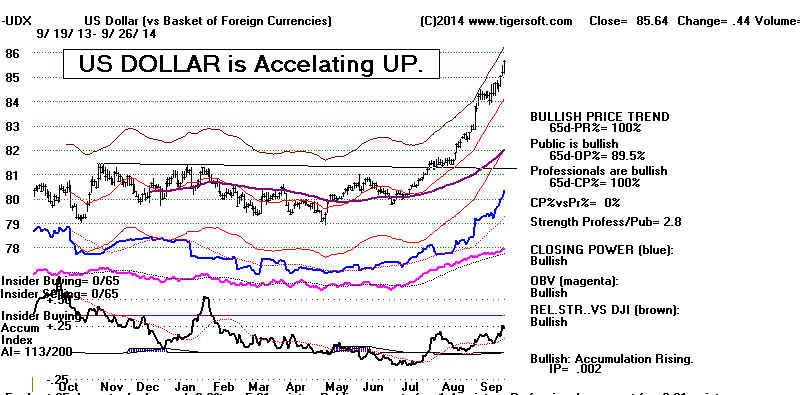
Deflationary Statistical Warnings
before
The Crash in 1929.
Our world economy is softening by most reports. Look at the Foreign ETFs'
downtrend. This has dangerous precedents. And were will the markets be found
for what
must be sold to drive profits? Even sending plants overseas may no longer help shore
up profits.
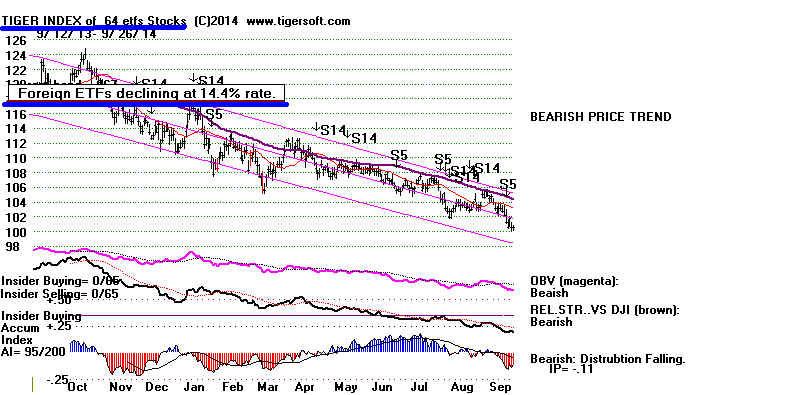
1929 offers some insights. It might be of interest to note that housing starts
peaked in the
Spring of 1923, 6 months before the DJI's top. The Federal Reserve's production
index
peaked in June 1929. By September, had declined 8%. April brought a simular
peak in Germany and July was the industrial production peak in Britain. The stock
markets
for Germany, Sweden and Switzerland peaked in 1929. (Source,
page 25.)|
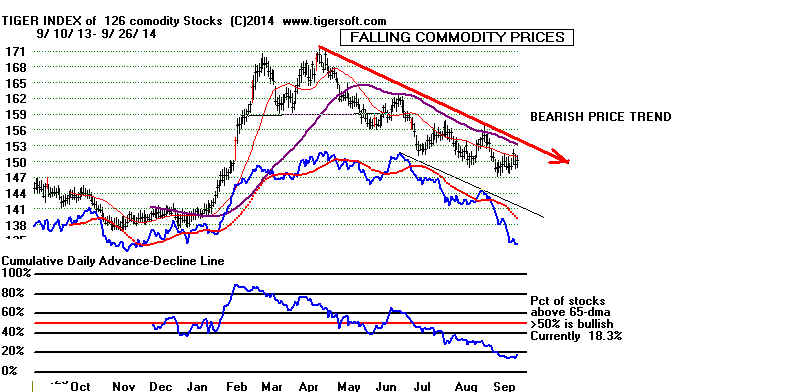
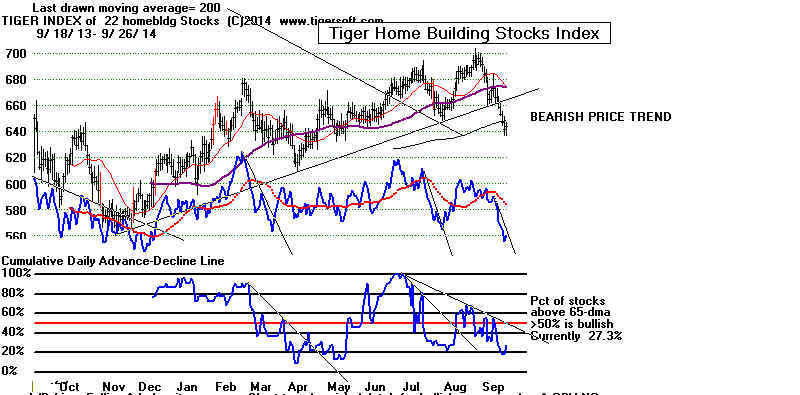
Deflation
in agriculural commodities, raw materials was severe in the 1920s. Coal and
crude
oil prices declined in the years before the Crash. Robert Prechter shows the how
commodities
and bonds topped out before the DJI-30 did in the 1920s.

Source: http://www.online-stock-trading-guide.com/financial-parallels-between-1920s/
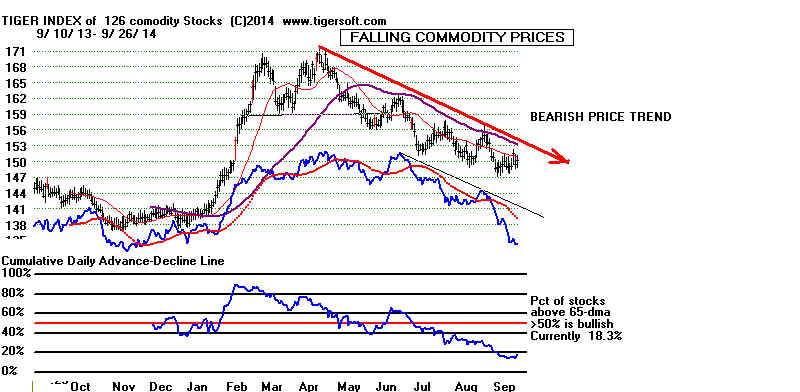
But a strong Dollar helps trhe stock market. Isn't that so? Certainly, a very
strong
Dollar makes blue chips a haven for hot overseas money fleeing their declining
currencies.
This was the hidden agenda for London's financial community in the 1920s and why
they lobbied so hard for a return to the Gold Standard when Churchill was Chancellor
of The Exchequer.
It's also true that the strong Dollar gives the biggest corporations the power to continue
to buy out their competition. And it's also true that the boost the strong Dollar
gives
share prices also allows the biggest corporations to continue to buy shares in their
own company without immediate risk that such a strategy will backfire. Buying
one's own shares is now a much-used short-term strategy to boost corporate
earnings. It placates the company's biggest shareholders and increases the net
worth nicely of those running the company, who are paid large stock bonuses.
In the short run, a strong Dollar is likely to boost profits and share prices for the
DJI and the SP-500.
The bull market depend upon the expectation of rising stock prices. As long as
US corporations' profits rise, the stock market as measured by the DJI and the SP-500
is probably be safe. But a turn-down in profits would be deadly. See how a turn down
in profits led to the bear markets of 1990, 2000 and 2007-8.
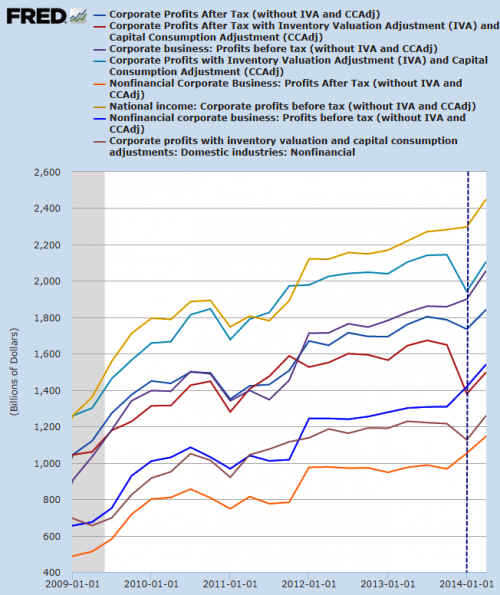
A
Republican Victory In November
A Republican victory in November should temporarily boost stock prices.
Republicans are certainly widely perceived as much more protective of blue chip profits.
And the turnout for the Democrats is likely to be light this Election.
But after that, how much longer can corporate profits rise. The Fed will not
do much more. Nor does it have the power to help much. The way out of
the dilema of a week economy is an expansionary fiscal pilicy, i.e. public works,
infrastructure rebuilding and improved mass buying power. But a more
Republican Congress will not allow this and Obama does not even propose
more Public Works expenditure. Obama is no a Keynesian. He is no
New Dealer. (Keynes advocated large schemes of public works after
1925 to improve the British economy. Only the weak and dying Liberal Party
empbraced his recommendations.)
The market's advance is long and tiring. Perhaps, a new rally will
start to bring in the bullish 3rd year of the Presidential cycle. But that's
asking a lot and what will bring it about? A continuation in the
profits' growth and buy-outs possibly. Better economic data would be
a big help. But the stronger Dollar will hurt US manufacturing even
as it helps Retailers who import what they sell.
The danger is that there will a sharp-sell off. There will be a panic, a rush to
the exits by those who are already nervously hoarding records amount of
cash. (The Fed records show that money velocity is at a 50-year low.)
All the leveraged short-ETFs will almost certainly accelerate and extend
the decline, just as they have promoted the bull market since 2009.
Watch the A/D Line trendline, the NYSE, the DJIs, the SP-500s, the
NASDAQ-100's and the Russel-1000's via the Tiger Hotline
That's the simplest approach and be careful what you buy. Most stocks
are in downtrends, the biggest corporations are more likely to be
holding steady.
As for the major market ETFs, if their Closing Power down trendlines are broken,
I'd become short-term bullish. Meanwhile, I'd use the 1.75% upper band as a
finder of where resistance is likely to be intense.
True - no Sells S9s, but there is an A/D Line divergence from rising DJI.
It would be much greater if interest rates were not pushing up
bond funds and dividend stocks. There are cases where there were no
Sell S9s and a market top. But you are right, the lengthy A/D, IP21
divergences and multiple S9s are not present now, as were seen
in 1929, 1973-1974, 1987 or 1999-2000.
We'll see. So much depends on what one trades.
If you'd like to read more about Keynes, see:
TigerSoft Blog - Keynes Revisited: Public Works Can Solve ...
Aug 3, 2011 -
Ignoring The Lessons of Keynes and Forgetting Economic
History
Put America in Needless Great Peril. America Is Following The Same ...






